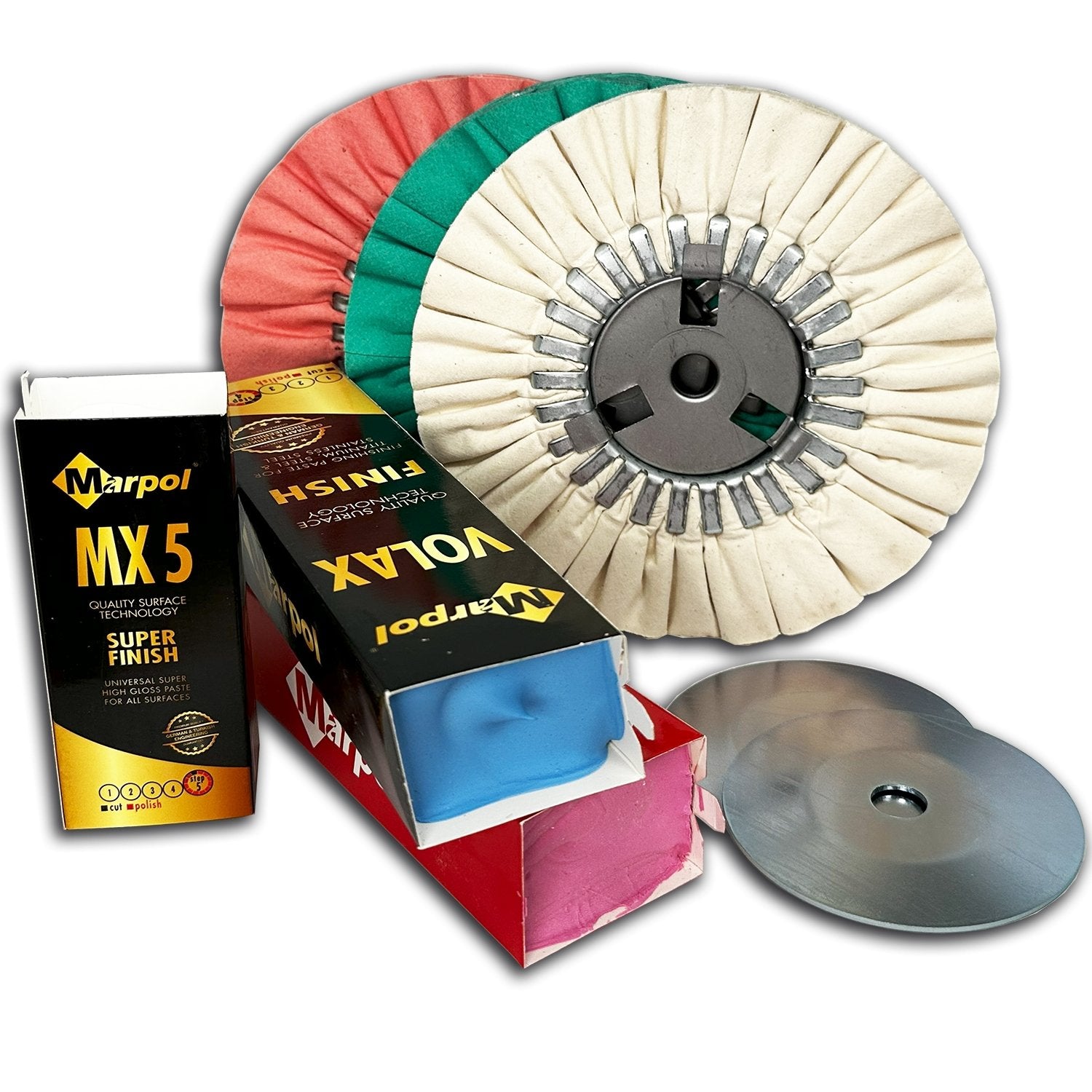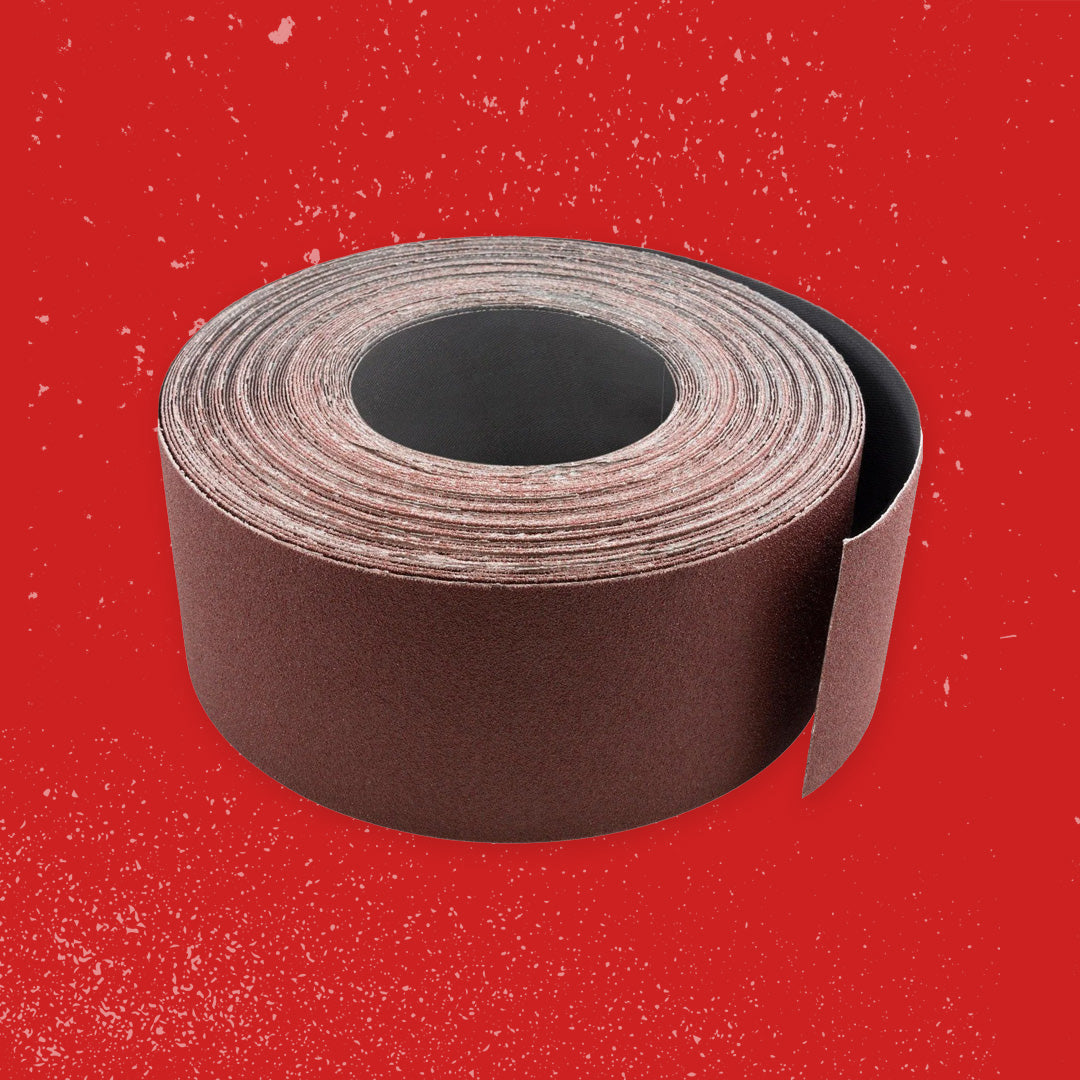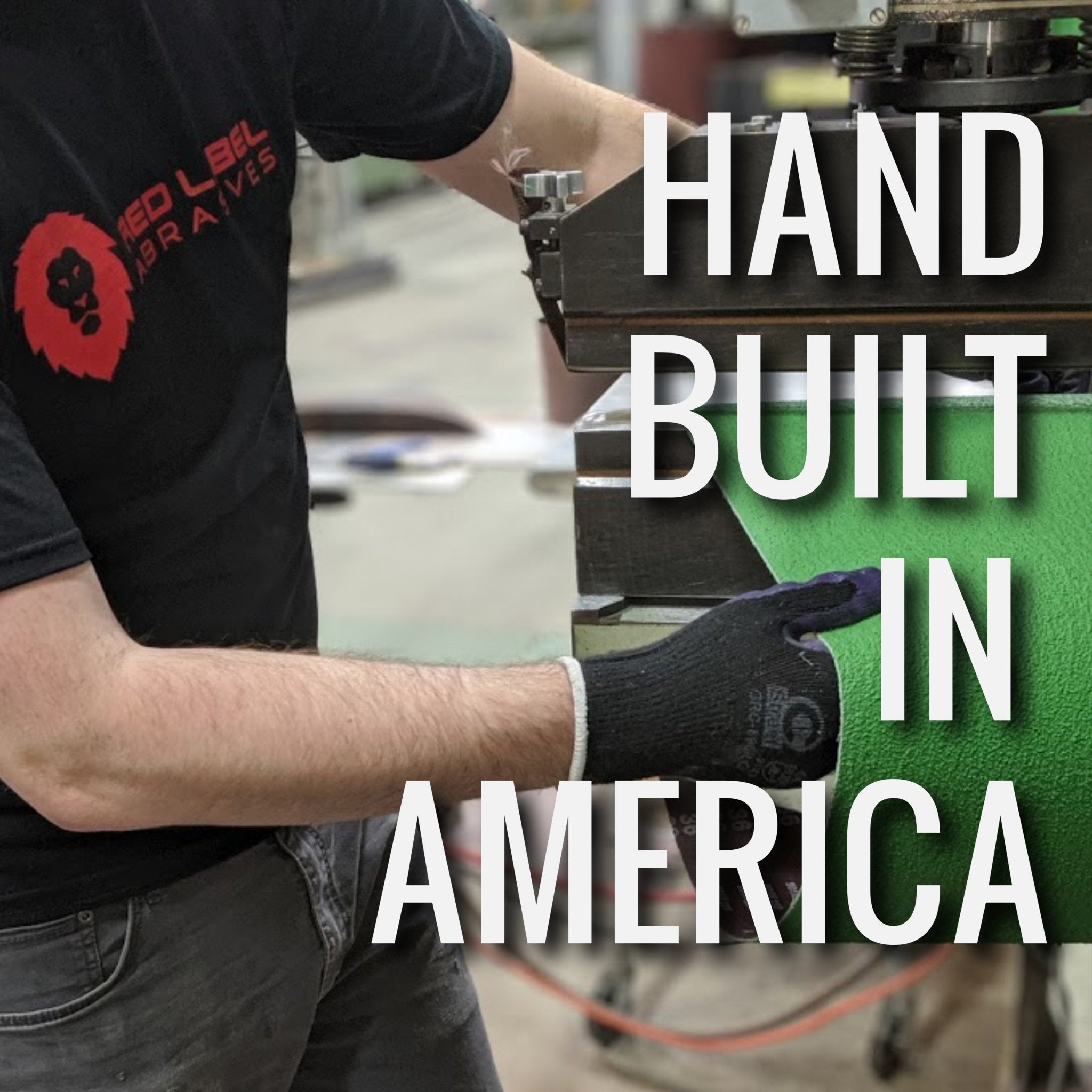Tu carrito está vacío
Envío gratis a partir de $150 (No incluye productos de gran tamaño)
Envío gratis a partir de $150 (No incluye productos de gran tamaño)
Bandas de lijado
Discos de lijado

Sandpaper Grit Chart & Grits Explained
por David Kranker 8 lectura mínima

Quick Overview
Sandpaper is an essential tool for shaping, smoothing, and finishing materials like wood, metal, and plastic. The right sandpaper grit, determined by the size of the abrasive particles, is crucial for efficient material removal and achieving desired finishes. Lower grit numbers are coarser abrasives for rapid material removal while higher numbers are for finer finishes. Various types of sandpaper materials, including aluminum oxide, silicon carbide, zirconia, and ceramic, cater to specific tasks and surfaces. Avoiding common mistakes, such as skipping grits, and oversanding, is also key to achieving the best results.
- Preparing wood for painting or staining
- Smoothing metal edges
- Stripping rust away from different types of metal
- Refinishing old furniture for DIY projects
- Creating knives and other metal tools and components
- Sharpening knives, scissors, and swords
When you’re selecting sandpaper for a particular project, you want to make sure you’ve got the right grit for the job. The correct choice helps you remove material efficiently, achieve smoother finishes, and avoid common mistakes like gouging and oversanding. In this blog, the abrasive technicians at Red Label Abrasives explain what the different grit sizes mean and how to choose the right one for your project.
Understanding Sandpaper Grit
Grit refers to the size of the abrasive grains bonded to the sandpaper. It is measured by the number of particles per square inch; therefore, the higher the grit number, the finer the abrasive particles. This means that sandpaper with a higher grit number will produce a smoother surface on the material being sanded.
When sandpaper is produced, it is filtered through a sifting machine using a 1-square-inch filter. The number of particles that can fit through the filter at once determines grit. As an example, if 36 particles could fit through the filter at once, you’d have 36 grit. If 80 particles could fit through the filter at once, you’d have 80 grit. The finer the particles are, the more of them fit through the filter.
CAMI vs. FEPA
In the United States, the Coated Abrasive Manufacturers Institute (CAMI) scaleis commonly used to measure sandpaper grit. This is what you’ll typically find in local hardware stores and lumber yards. However, there is another scale known as the Federation of European Producers of Abrasives (FEPA) scale, which also happens to be the one used by Red Label Abrasives.
The FEPA scale, identified by a "P" before the grit number (e.g., P220), is recognized for its strict tolerance system, which requires manufacturers to meet certain standards to qualify for grit ratings. FEPA grit sizes range from P8, which is very coarse, up to P1200 and beyond, which are extremely fine.
Why Is Grit Size So Important?
Grit size is important because it directly affects the surface finish and the rate at which material is removed from the workpiece. As stated earlier, sandpaper grit is measured by the number of abrasive particles per square inch; a lower number means fewer, larger particles, while a higher number means more, smaller ones.
For rough sanding and removing large amounts of material quickly, you'll want to use a coarser grit, such as P8 to P80 grit. These larger abrasive particles cut through material faster but leave behind more noticeable scratches and a rougher surface. As you progress to finer grits, such as P100 to P240, you'll start to smooth out the roughness left by the coarser grits. These medium grits are ideal for general sanding and preparation before applying finishes.
For finishing touches or preparing surfaces for painting or staining, finer grits like P240 and above are used. These grains smooth the surface further and help ensure a clean, attractive finish. Extremely fine grits are often used between coats of paint or varnish to achieve an ultra-smooth finish.
Choosing the right grit size is about balancing the speed of material removal with the desired surface finish. Starting with a grit that is too fine for the task can be time-consuming and ineffective, while starting with a grit that is too coarse can damage the surface, making it harder to achieve a smooth finish later on. The key is to start with a coarser grit to do the heavy lifting and gradually work your way up to finer grits to achieve the desired surface smoothness.
Sandpaper Grit Charts By Scale
The chart below illustrates the various FEPA and CAMI scale sandpaper grits and their specific uses. By consulting it, you can easily determine which grit size is best suited for your particular project.
|
Category |
Grit Range |
Applications |
|
Coarse Grit |
P8 - P80 8 - 80 |
Ideal for aggressive stock removal. It’s commonly used for stripping old paints, varnishes, and finishes from surfaces. Coarse grit sandpaper quickly removes material, making it suitable for the initial stages of a project. |
|
Medium Grit |
P100 - P220 100 - 220 |
Medium grit sandpapers are recommended for prepping materials for paints, stains, and varnishes. They can also be used for final shaping, planing mark removal, and honing and sharpening certain tools. |
|
Fine Grit |
P240 and finer 240 and finer |
Fine grits are used primarily for finishing tasks. This includes sharpening blades to a fine edge and polishing surfaces to a high shine. |
How to Choose the Right Grit for Your Project
In order to achieve the desired finish, you need to choose the right sandpaper grit at each stage of your project. When you’re starting with a raw material, the most common approach is to start with coarser grits and progress to finer ones. This method allows for rapid material removal, followed by gradual refinement of the surface to the desired smoothness.
Let’s assume you want to strip the varnish off of an old wooden table and refinish it. Starting with a coarser grit sandpaper, such as P40 to P80, will let you quickly remove the old finish. After the rough work is done, you can switch to medium grits, like P100 to P220, to refine the surface and eliminate any scratches and marks left by the coarse sandpaper. Finally, you can use fine-grit sandpaper (P240 and above) to smooth the surface and prepare it for painting, staining, or polishing.
Additional Tips
- Test on a Small Area: If you're unsure about the right grit to start with, test the sandpaper on a small, inconspicuous area of your material. This can help you assess the effectiveness without risking damage to the entire piece.
- Consider the Final Finish: Your end goal should influence your choice of grit. If you're aiming for a highly polished finish, ending with a very fine grit is essential. For surfaces that will be painted or stained, ensure the final grit is fine enough to create a smooth base without over-sanding.
By understanding the relationship between sandpaper grits and the materials you are working with, you can make informed decisions that lead to better finishes and more successful projects.
Types of Sandpaper and Their Grits
Sandpaper comes in a variety of materials, each suited for specific tasks and surface types. Understanding the differences between these materials is key to selecting the right abrasive for your project. Below is a rundown of the most common types of sandpaper materials and their uses.
Aluminum Oxide
Aluminum oxide is one of the most popular choices for woodworking and metalworking. It's cost-effective, durable, and suitable for a wide range of applications. It also works well on a variety of materials, including wood, metal, and plastic. However, its lower price point comes at a cost, as aluminum oxide sandpaper tends to wear down quicker than other types.
Silicon Carbide
Silicon carbide is known for its sharpness and ability to quickly cut through surfaces. It's ideal for working with harder materials, such as metal and glass. Silicon carbide is also a preferred abrasive for wet sanding applications due to its resistance to water, and its ability to remove material without generating excessive heat makes it ideal for heat-sensitive applications.
Zirconia
Zirconia is both aggressive and durable, making it an excellent choice for hardwood material removal as well as the grinding and polishing of metal workpieces. Sandpaper made from zirconia rarely exceeds 220 grit.
Ceramic
Ceramic is extremely durable and can cut through tough materials quickly. It's often used in industrial applications and for sanding rough surfaces. Ceramic is typically available in 24 through 120 grit, with most abrasive manufacturers offering a maximum of 220 grit (Red Label Abrasives, however, offers ceramic belts up to 400 grit). These abrasives stay sharp for a long time, making them cost-effective for heavy-duty tasks
Whether you’re preparing a surface for finishing, smoothing out imperfections, or removing old paint, there’s a sandpaper material and grit that’s appropriate for the job. Understanding these options allows you to match your approach to the material you’re working with and achieve the desired finish.
Open vs. Closed Coat Sandpaper Explained
With open-coat and closed-coat sandpaper, the key distinction lies in how much of the backing material is covered by abrasive grains.
- In closed-coat sandpaper, the abrasive grains are packed tightly together, covering nearly the entire surface of the backing material. This high density ensures a more uniform finish on the material being sanded.
- Open-coat sandpaper features a backing that is only partially covered with abrasive grains (typically between 50% to 70%). This design allows space for sawdust, metal filings, and other debris to accumulate without clogging the sandpaper, facilitating a more efficient sanding process for certain materials.
- Semi-open or semi-closed sandpaper has around a 30% reduction in grit coverage compared to fully closed coats. This design strikes a balance between preventing loading and providing a smooth finish.
Open coats are best for materials that tend to clog sandpaper (i.e. softwood) while closed coats are ideal for achieving fine finishes on solid surfaces.
Common Mistakes to Avoid
When working with sandpaper, certain missteps can lead to less than satisfactory results on your projects. Being aware of these common errors, which are highlighted below, can help you achieve a smoother finish and make your sanding process more efficient.
Skipping Grits
Many attempt to save time by jumping from a very coarse grit directly to a fine grit and skipping intermediary steps. However, skipping grits results in deep scratches and a rough finish. It’s essential to progress through grits gradually, allowing each to properly refine the surface left by the previous one.
Using the Wrong Sandpaper Type for the Material
Different materials require specific types of sandpaper. For example, using open-coat aluminum oxide, which is ideal for softwoods, on metal might not yield the best results and could wear out the sandpaper quickly. Matching the sandpaper to the material ensures effective sanding as well as product longevity.
Over-Sanding
Over-sanding can lead to unnecessary removal of material, potentially altering the shape or look of your project. It can also create a surface that’s too smooth for finishes to stick to, leaving you with an undesirable result.
Not Cleaning the Surface Between Grits
When you’re sanding with finer grits, residual debris, and dust can accumulate and cause scratches on the surface. Cleaning between grits with a cleaning stick helps ensure that each sanding step is as effective as possible.
We Have a Wide Range of Sandpaper Grits at Red Label Abrasives
The key to achieving optimal results in any sanding project lies in understanding and selecting the appropriate sandpaper grit. The right grit size can make the difference between a project that looks professionally done and one that falls short of expectations. By starting with coarser grits for rapid material removal and progressing to finer grits for smoothing and finishing, you can ensure a high-quality finish on a wide range of materials.
At Red Label Abrasives, we manufacture industrial-grade abrasives that are engineered for the best results. This includes sanding belts, sanding discs, sanding sheets, and specialty abrasive products like knife-making kits. If you have questions or would like to place an order, please contact us by calling 844-824-1956 or filling out our contact form today.Ver artículo completo

What Are The Best Sanding Discs For Automotive Work?
por David Kranker 7 lectura mínima
Ver artículo completo
What Is The Best Sandpaper To Remove Paint?
por David Kranker 8 lectura mínima
Ver artículo completo
Tanto vs Drop Point Blades: Which Blade Type Is Better?
por David Kranker 8 lectura mínima
Ver artículo completo SOBRE EL AUTOR
David Kranker es un escritor y creador creativo que ha estado cubriendo las industrias de abrasivos y de fabricación de cuchillos en el Blog de Red Label Abrasives desde 2020. David dedica su tiempo a investigar continuamente sobre lijado y cuchillería para brindar a los lectores la mejor y más reciente información. En su tiempo libre, David utiliza abrasivos para muchos proyectos diferentes de hogar y automóvil en su casa de Delton, MI.
Our Most Popular Abrasives

EdgeCore Ceramic Sanding Belts

EdgeCore Ceramic Flap Discs

Buffing Kit
Shop By Product Category





Why Choose Red Label?




